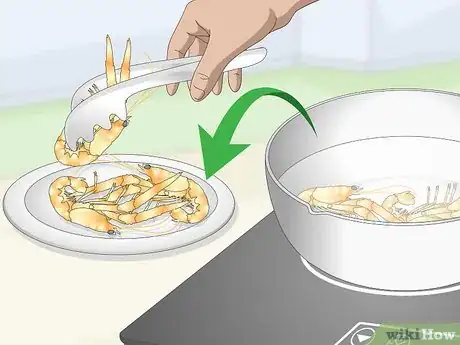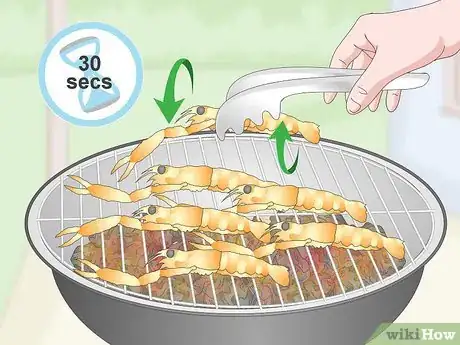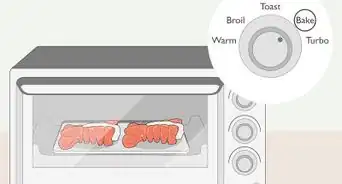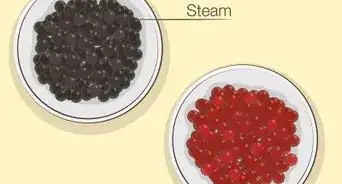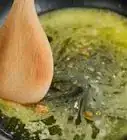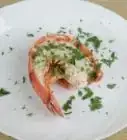X
This article was co-authored by wikiHow Staff. Our trained team of editors and researchers validate articles for accuracy and comprehensiveness. wikiHow's Content Management Team carefully monitors the work from our editorial staff to ensure that each article is backed by trusted research and meets our high quality standards.
This article has been viewed 65,502 times.
Learn more...
There are several ways to cook langoustines, also known as the Norway lobster, that are simple and delicious. Larger langoustines are best when they're cut in half and grilled, while smaller ones are great boiled. Remove the shells from the langoustines before eating them, and use any seasonings to add flavor if desired.
Steps
Method 1
Method 1 of 2:
Boiling and Peeling Langoustines
-
1Bring a pot of salted water to a boil. How much water you use will depend entirely on how many langoustines you’re cooking, but a medium to large pot should work. Add 1–2 tsp (4.9–9.9 ml) of salt to the water before bringing it to a boil.[1]
- Measure out enough water to completely submerge each langoustine.
-
2Place the langoustines in the boiling water for 3 minutes. Once the water is boiling, carefully set the langoustines in the water. Set a timer for 3 minutes and let the langoustines cook in the water for this amount of time.[2]
- Use the timer on your phone, or use a kitchen timer that’s set next to the pot.
- You can boil langoustines alive, though it's more common to purchase them already on ice before boiling them.
Advertisement -
3Remove the langoustines from the water and let them cool. After the 3 minutes are up, use tongs to remove the langoustines from the water and set them on a plate to cool. As they’re completely done cooking, it’s fine to place them on a serving dish or the plate you’ll be using to eat.[3]
- When the tails are fully cooked, the flesh will be white instead of translucent.
- Let them cool for 5 minutes or so, and if you’re not sure whether they’re still hot or not, do a quick touch test to see if their shells are too hot to hold.
-
4Peel the langoustines by twisting apart the head end and tail end. Hold the tail end in one hand and the head in another, using your pointer finger and thumb to grip the langoustine. Twist the tail and head apart from one another so that the shell splits and you’re holding 2 halves.[4]
- Discard the head, though some people choose to suck out any leftover juices from the head before throwing it away.
-
5Slide the shell off of the tail end to reveal the meat. Now that you’re only holding the tail end, use 2 fingers to grip the tail and slide the shell off slowly so that you’re left with the meat. If this doesn’t work, hold the tail vertically and use your fingers to break the shell off of the meat on each side.[5]
- By pulling the shell off slowly, you’ll likely remove the vein easily as well, which is part of the langoustine's digestive system.
- If you still see the brown, thin vein in the langoustine, simply pull it out with your fingers or use a kitchen tool to pull it out.
-
6Dip the meat in a sauce before eating it, if desired. Many people choose to dip their langoustines in garlic mayo or similar sauces. Choose a sauce for your langoustine to add additional flavor, and keep a bowl nearby for discarded shells as you’re eating.[6]
- Some people sauté the meat in sauce before putting it over a salad as well.
Advertisement
Method 2
Method 2 of 2:
Cutting and Grilling Langoustines
-
1Lay the langoustines on a cutting board belly-side down. Place your clean cutting board on the table and lay out your langoustines. You’ll be cutting their shells, so place them with their stomachs flat on the cutting board.[7]
- The langoustines should be dead at this stage, and fresh are always better than frozen.
-
2Use a sharp knife to slice them in half vertically. Use the tip of your knife to make the first slice, working your way down the length of the langoustine. Once you’re finished cutting it in half, you should be left with 2 long, identical pieces.[8]
- Using the tip of your knife will help you break through the harder outer shell.
- The shell will remain on the langoustine until after you've finished grilling it and are ready to eat.
-
3Remove the gut and the vein from each one. Use your fingers to take out the gut and vein, though you can opt for using tweezers to remove the vein from the langoustine if desired. The gut is a round section near the head, while the vein is a long, usually darker string-like piece that can be pulled from the end.[9]
- You don’t want to eat either of these sections, which is why removing them is important.
- If you’re having trouble identifying the gut or vein, do a quick online search to find a picture of a langoustine to help you.
-
4Brush the meat with melted butter, if desired. To add some flavor, melt 1–3 US tbsp (15–44 ml) of butter, depending on how many langoustines you’re cooking, in a small bowl before using a basting brush to spread butter on the langoustines. Cover one or both sides of each section with the butter.[10]
- Feel free to add other ingredients, such as lemon juice, salt, pepper, or parsley, to the langoustines as well.
-
5Grill the langoustines for 2 minutes on the first side. With your grill heated up and ready to go, set the langoustines across the bars so that they won’t fall through. Set a timer for 2 minutes, keeping the langoustines on the same side without flipping them.[11]
-
6Flip the langoustines and cook them for 30 seconds. Use tongs to carefully flip each langoustine after the first 2 minutes have passed. After another 30 seconds or so, turn off the grill.[12]
- Once the langoustines are cooked, the meat will be white instead of translucent.
-
7Remove the langoustines from the grill and let them cool before serving. Use tongs to remove the langoustines from the grill and set them on a clean serving plate. Wait 5-10 minutes for them to cool before serving them and eating.
- Use a fork to remove the meat from the shell.
Advertisement
Things You'll Need
Boiling the Langoustines
- Large pot
- Timer
- Tongs
- Plate
Grilling the Langoustines
- Cutting board
- Knife
- Tongs
- Basting brush
- Grill
- Timer
- Plate
References
- ↑ https://www.foodnetwork.com/fn-dish/how-to/2014/07/everything-you-need-to-know-about-langoustines
- ↑ https://lecoindemel.com/langoustines-where-to-get-them-how-to-cook-them-how-to-peel-them/
- ↑ https://lecoindemel.com/langoustines-where-to-get-them-how-to-cook-them-how-to-peel-them/
- ↑ https://lecoindemel.com/langoustines-where-to-get-them-how-to-cook-them-how-to-peel-them/
- ↑ https://www.youtube.com/watch?v=sNMuM3tj4pI
- ↑ https://www.foodnetwork.com/fn-dish/how-to/2014/07/everything-you-need-to-know-about-langoustines
- ↑ https://www.youtube.com/watch?v=sNMuM3tj4pI
- ↑ https://www.youtube.com/watch?v=sNMuM3tj4pI
- ↑ https://www.youtube.com/watch?v=sNMuM3tj4pI
About This Article
Advertisement


